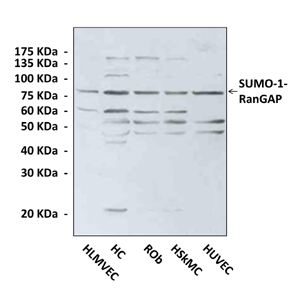Product Sheet CC10018
Description
BACKGROUND SUMO-1 is a small polypeptide of 101 amino acid residues that belong to the ubiquitin-like protein family. SUMO-1 is covalently linked to many cellular and viral protein targets. Modification by SUMO-1 is proposed to play a role in protein targeting and/or stability.1
SUMO-1 resembles ubiquitin in its structure, and the reversible attachment of SUMO is controlled by an enzyme pathway that is analogous to the ubiquitin pathway. However, in contrast to ubiquitination, whereby the modification is often the first step on the path to protein degradation, sumoylation does not seem to mark proteins for degradation. In fact, SUMO-1 may even function as an antagonist of ubiquitin in the degradation of selected proteins.
Sumoylation is often targeted to lysines in the cKXE motif (where c represents a hydrophobic amino acid, and X is any amino acid). However, lysines that are not embedded in the cKXE motif can also be targeted by SUMO.2
Known substrates of SUMO-1 include various cell regulatory proteins that participate in diverse cellular processes, including transcriptional regulation, nuclear transport, maintenance of genome integrity, and signal transduction.
Sumoylation accumulates Ran GTPase activating protein (RanGAP1) at the nuclear pore, and transports Sp100 to promyelocytic leukaemia (PML) nuclear bodies. Modification of transcription factors by SUMO-1, including those in the p53, c-Jun, Sp3, c-Myb and C/EBP families, reduces transcriptional activity. Sumoylation stabilizes CREB, MDM2 and IkBa by blocking ubiquitination. SUMO-1 also modulates cytokines, Wnt, AP-1 and steroid hormone signaling pathways by conjugating with STAT1, LEF-1, c-Jun, Elk-1, IIkBa and androgen receptor.
SUMO-1 can regulate cellular processes without the characteristic conjugation.3 SUMO-1 inhibits RAD51-mediated homologous recombination by interaction with RAD51. SUMO-1 interacts with Fas and tumour necrosis factor receptor 1 (TNFR1), and provides protection against cell death, although covalent modifications of Fas and TNFR1 have not been observed. SUMO-1 can also inhibit dynamin-dependent endocytosis without the covalent modification of dynamin.
REFERENCES
1. Melchior F: Ann. Rev. Cell Dev. Biol. 16: 591-626, 2000.
2. Johnson ES: Ann Rev. Biochem. 73: 355-382, 2004.
3. Li W et al.: Nucleic Acids Res. 23:1145-1153, 2000.
2. Johnson ES: Ann Rev. Biochem. 73: 355-382, 2004.
3. Li W et al.: Nucleic Acids Res. 23:1145-1153, 2000.
Products are for research use only. They are not intended for human, animal, or diagnostic applications.

(Click to Enlarge) Western Blot detection of endogenous SUMO-1 protein in normal primary cell lysates using SUMO-1 Antibody. HLMVEC: Human Lung Microvascular Endothelial Cells. HC: Human Chondrocytes. ROb: Rat Osteoblasts. HSkMC: Human Skeletal Muscle Cell. HUVEC: Human Umbilical Vein Endothelial Cells.
Details
Cat.No.: | CC10018 |
Antigen: | Recombinant human SUMO-1 protein expressed in E. coli. |
Isotype: | Mouse IgG2b |
Species & predicted species cross- reactivity ( ): | Human, Rat, Mouse |
Applications & Suggested starting dilutions: | WB 1:1000 IP 1:50 IHC 1:100 ICC n/d FACS n/d |
Predicted Molecular Weight of protein: | 80 kDa (SUMO-1-RanGAP) |
Specificity/Sensitivity: | Detects endogenous levels of SUMO-1 protein in various cell lysates. |
Storage: | Store at 4° C for frequent use; at -20° C for at least one year. |
*Optimal working dilutions must be determined by end user.
Products
| Product | Size | CAT.# | Price | Quantity |
|---|---|---|---|---|
| Monoclonal SUMO-1 Antibody: Monoclonal SUMO-1 Antibody | Size: 100 ul | CAT.#: CC10018 | Price: $302.00 |
